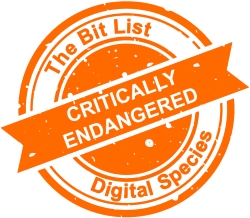Evidence in Court
|
|
 |
|
|
Digital materials presented in court as evidence or documents such as rulings and proceedings generated through legal proceedings |
||
|
Digital Species: Legal Data |
Trend in 2023:
|
Consensus Decision |
|
Added to List: 2017 |
Trend in 2024:
|
Previously: Critically Endangered |
|
Imminence of Action Action is recommended within three years, detailed assessment within one year. |
Significance of Loss The loss of tools, data or services within this group would impact on people and sectors around the world. |
Effort to Preserve | Inevitability It would require a major effort to address losses in this group, possibly requiring the development of new preservation tools or techniques. |
|
Examples Evidence submitted to courts of all kinds, including text messages, photography, CCTV, email, 3d and 2d scanning, scientific reports and analyses, documents and websites. |
||
|
‘Practically Extinct’ in the Presence of Aggravating Conditions Loss of context; loss of integrity; external dependencies; poor storage; lack of understanding; churn of staff; significant or diversity of data; poorly developed specifications; ill-informed records management; poorly developed transfer protocols; poorly developed migration or normalization; longstanding protocols or procedures that apply unsuitable paper processes to digital materials; Uncertainty over IPR or the presence of orphaned works. |
||
|
‘Endangered’ in the Presence of Good Practice Well-managed data infrastructure; preservation enabled at ingest; carefully managed authenticity; use of persistent identifiers; finding aids; well-managed records management processes; recognition of preservation requirements at highest levels; strategic investment in digital preservation; preservation roadmap; participation in digital preservation community. |
||
|
2023 Review This entry is a subset of an entry made in 2019 titled ‘Proceedings and Evidence in Court,’ which was itself created as a subset of entry in 2017 for ‘Digital Legal Records and Evidence,’ The 2021 Jury split ‘Proceedings and Evidence in Court’ into two more discrete entries to highlight their distinct preservation challenges and risk profiles. This entry includes evidence that has been presented as evidence in court. It was given a Critically Endangered classification to highlight its higher risk profile and additionally emphasize that courts are not limited in the types of evidence that they can admit but that they have a responsibility to provide robust preservation that ensures the authenticity of their records and evidence. The 2022 Taskforce found no significant trend towards greater or reduced risk The 2023 Council agreed with the Critically Endangered classification with the overall risks remaining on the same basis as before (‘No change’ to trend). They emphasized the importance that organizations with these materials should have identified preservation actions established in their workplan–for digital evidence of investigation prior to court–to put into practice within the next three years. |
||
|
2024 Interim Review These risks remain on the same basis as before, with no significant trend towards even greater or reduced risk (‘No change’ to trend). |
||
|
Additional Comments Temporary courts are continuing to gradually close and decisions about preservation and management of their archives are being made hurriedly and at the last minute. Some of the decisions are placing materials at high risk due to; materials being split all over the place - including to entities with no capacity or capability to preserve them, a seeming lack of understanding that preservation and management of the archives has no completion date, an unwillingness to invest in preservation or a drive to keep costs low which is resulting in negative implications for preservation, hurried choices on preservation measures which are not allowing for proper testing of approaches to safeguard authenticity and legal admissibility (e.g. extracting digital data from complex systems in formats that can then potentially not be restored). Standard Records Management processes within designated agencies should be able to take care of the preservation of materials like this but given that it is likely to involve complex types of data, such agencies may not be equipped to deliver preservation effectively. It is surprising that courts are not more prominent in the digital preservation community, where solutions now exist. Case Studies or Examples:
More concrete examples would be welcome. It is the evidentiary value of submissions to court that may be lost, and therefore veracity of the decision could be questioned. Evidence submitted in digital form is of greater risk (e.g., a video file submitted on a CD in the 90s) than records of the proceedings themselves (e.g., transcripts). |
||





































































































































